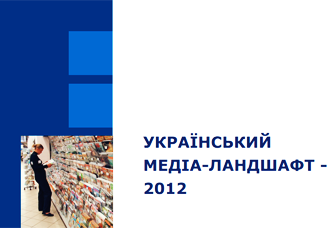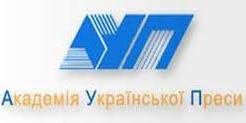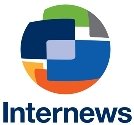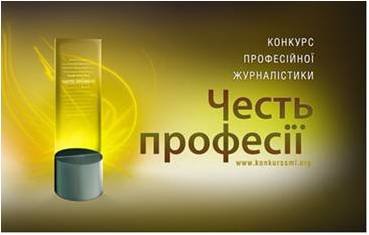Схожі новини
 Академія української преси презентувала аналітичний звіт «Український медіаландшафт-2012» за підтримки Фонду Конрада Аденауера та програми «У-Медіа», Інтерньюз.
Академія української преси презентувала аналітичний звіт «Український медіаландшафт-2012» за підтримки Фонду Конрада Аденауера та програми «У-Медіа», Інтерньюз.
 Академія української преси (АУП) представила он-лайн модуль для педагогів з медіа освіти «Як створити шкільну газету». Автор навчального курсу - медіа-тренер Сергій Чернявський покроково розглядає роботу шкільної газети - від створення редакційної ради та наповнення контентом до просування газети через соціальні мережі. Випуск шкільної газети та набуття базових навичок з створення медійних матеріалів є одним з найефективніших кроків у розвитку медіаграмотної особистості. Цим методологічним матерілом АУП продовжує надавати методологічну підтримку викладачам курсу медіа освіти в середніх загальноосвітних учбових закладах.
Академія української преси (АУП) представила он-лайн модуль для педагогів з медіа освіти «Як створити шкільну газету». Автор навчального курсу - медіа-тренер Сергій Чернявський покроково розглядає роботу шкільної газети - від створення редакційної ради та наповнення контентом до просування газети через соціальні мережі. Випуск шкільної газети та набуття базових навичок з створення медійних матеріалів є одним з найефективніших кроків у розвитку медіаграмотної особистості. Цим методологічним матерілом АУП продовжує надавати методологічну підтримку викладачам курсу медіа освіти в середніх загальноосвітних учбових закладах.
 Міжнародний благодійний фонд «Академія Української Преси» запрошує Вас до участі в медіаланчі, який відбудеться 11 червня 2013 р. за адресою: м. Київ, вул. Мала Житомирська, 20, кафе Вино-Барель з 10.00 до 11.30.
Міжнародний благодійний фонд «Академія Української Преси» запрошує Вас до участі в медіаланчі, який відбудеться 11 червня 2013 р. за адресою: м. Київ, вул. Мала Житомирська, 20, кафе Вино-Барель з 10.00 до 11.30.
Цим заходом Академія Української Преси продовжує серію зустрічей з журналістами та представниками міжнародних організацій, на яких будуть презентовані результати моніторингу провідних медіа України.
 Internews presented fidnings of its annual survey of Ukrainian journalists in 2012. Overall goal of the survey was studying journalists’ professionalism and needs in training and other technical support. The research studied journalists’ perception of cesorship, paid journalism and freedom of speech, learned about inside and outside factors impacting the quality of journalist work including legal knowledge, adherence to ethical standards of journalism, employment relations, needs in professional training. The report showed to which extend Ukrainian media consider audience’s interests.
Internews presented fidnings of its annual survey of Ukrainian journalists in 2012. Overall goal of the survey was studying journalists’ professionalism and needs in training and other technical support. The research studied journalists’ perception of cesorship, paid journalism and freedom of speech, learned about inside and outside factors impacting the quality of journalist work including legal knowledge, adherence to ethical standards of journalism, employment relations, needs in professional training. The report showed to which extend Ukrainian media consider audience’s interests.
 Експерти Центру Політичних Студій та Аналітики (ЦПСА) провели громадський моніторинг «закритих» закупівель Вінницької облдержадміністрації на предмет ефективності використання бюджетних коштів. За результатами дослідження було встановлено, що Головне управління житлово-комунального господарства, енергетики та зв'язку Вінницької ОДА протягом двох років приховувало документацію конкурсних торгів, внаслідок чого 38,75%(15,09 млн. гривень) бюджетних коштів запланованих на ремонт доріг, потрапили на рахунок однієї фірми.
Експерти Центру Політичних Студій та Аналітики (ЦПСА) провели громадський моніторинг «закритих» закупівель Вінницької облдержадміністрації на предмет ефективності використання бюджетних коштів. За результатами дослідження було встановлено, що Головне управління житлово-комунального господарства, енергетики та зв'язку Вінницької ОДА протягом двох років приховувало документацію конкурсних торгів, внаслідок чого 38,75%(15,09 млн. гривень) бюджетних коштів запланованих на ремонт доріг, потрапили на рахунок однієї фірми.
 25 квітня конкурс професійної журналістики "Честь професії 2013" оголосив роботи-переможці у шести номінаціях. Церемонія нагородження перетворилась на тріумф якісної небайдужої журналістики, яка не лише вісвітлює проблеми, але й сприяє їх вирішенню. Жюрі, що складалось з 12 поважних журналістів та медіа експертів, обирало шість переможців з понад 930 робіт, що були подані на конкурс. Серед переможців - три телевізійні програми - Агенти впливу (НТН) - 2 номінації, ТСН-новини (1+1) та Тендер Ньюз (ТВі), а також публікації у журналі Український тиждень та інтернет газеті "Фраза".
25 квітня конкурс професійної журналістики "Честь професії 2013" оголосив роботи-переможці у шести номінаціях. Церемонія нагородження перетворилась на тріумф якісної небайдужої журналістики, яка не лише вісвітлює проблеми, але й сприяє їх вирішенню. Жюрі, що складалось з 12 поважних журналістів та медіа експертів, обирало шість переможців з понад 930 робіт, що були подані на конкурс. Серед переможців - три телевізійні програми - Агенти впливу (НТН) - 2 номінації, ТСН-новини (1+1) та Тендер Ньюз (ТВі), а також публікації у журналі Український тиждень та інтернет газеті "Фраза".
 Академія української преси (АУП) прозвітувала про квітневу хвилю контент аналізу новин восьми національних телеканалів. Дослідження показало незначне підвищення долі збалансованого контенту - до 23%, частка політичних новин збільшилась до 26%. Увага до правлячої коаліції у 1,7 разів перевищує увагу до опозиції; 47% прямої мови у новинах - доповіді та інтерв'ю представників влади. Іронічні інтонації характерні для новин, що висвітлюють дії як опозиції так і правлячої групи.
Академія української преси (АУП) прозвітувала про квітневу хвилю контент аналізу новин восьми національних телеканалів. Дослідження показало незначне підвищення долі збалансованого контенту - до 23%, частка політичних новин збільшилась до 26%. Увага до правлячої коаліції у 1,7 разів перевищує увагу до опозиції; 47% прямої мови у новинах - доповіді та інтерв'ю представників влади. Іронічні інтонації характерні для новин, що висвітлюють дії як опозиції так і правлячої групи.
 The Academy of Ukrainian Press (AUP) conducted next wave of the content analysis of new programming at eight leading TV channels of Ukraine. In April 2013, the channels had 23% of balanced reporting; share of reports on political issues increased to 26% of all news.
The Academy of Ukrainian Press (AUP) conducted next wave of the content analysis of new programming at eight leading TV channels of Ukraine. In April 2013, the channels had 23% of balanced reporting; share of reports on political issues increased to 26% of all news.
- У-Медіа » Медіа і демократія » Медіа моніторинг » News of Ukrainian channels pay more attention to ruling Party of Regions
- Переглядів: 141
- Автор: Irina
- Дата: 7-05-2013
News of Ukrainian channels pay more attention to ruling Party of Regions
Категорія: Медіа моніторинг, Новини, Media Research, News
Top channels news: enforcement agencies and local government bodies are the leaders of attention in the news
- The share of political news in April was 26% of all reports;
- 23% was the share of political news with two viewpoints; this practice is the most popular at Novy Channel and Inter; Pershy Natsionalny features the smallest share;
- Inter features the most balanced attention to political parties’ representatives and direct speech
- Compared to the situation in March the attention to political parties decreased; that to political institutions – increased;
- Enforcement agencies and local government bodies are the leaders of attention among political institutions; similarly to February and March the leaders of attention among political groups are the Opposition (as a general notion) and Party of Regions;
- The attention to the ruling coalition is 1.7 times higher than that to the opposition;
- In April the share of direct speech allocated for the ruling authorities is 1.9 times more than that of the opposition (In March – 1.2 times more, in February – 2.1 times more, in January – by 1.4 times more);
Political news. During the first week of April 26% of all news reports were related to political events in Ukraine (the third week of January – 20%, the first week of February – 25%, in March – 25%). TVi features the biggest share – 36% (February – 51%, January – 34%, March – 39%), followed by Inter – 32% and Novy Channel – 31% (in March – 37%, in February – 30%). 1+1 channel news include 71% of non-political reports (in January – 69%, in February – 66%, in March – 59%). TVi broadcast the biggest share of the international political news related to Ukraine – 8% (in March – 9%, in February it was TRC Ukraine – 10%). UT-1 is the leader in terms of broadcasting the international news not related to Ukraine – 32% (in March – 36%).
Domestic policy, government bodies’ activities – 46% (in March – 38%, in February - 43%, in January 39%), social support sphere – 30% (in March – 28%, in February - 24%) and environmental issues – 21% (in March - crime – 20%, in February - 21%, in January - 28%) constitute the key topics for news. Natural calamities – 14%, car accidents, disasters (13%), culture and sport – 12% are the most frequently mentioned events.
Balance in the news reports. 23% of the reports included several viewpoints (in January - 18%, in February – 24%, in March – 27%). TVi features 44% share, Inter – 39%, Novy Channel – 34% (in March STB’s share of the news with several viewpoints was 38%, Inter’s - 36%). In April – two viewpoints were provided in 32% of the reports (in March – 44%, in February – 43%, in January - 36%). STB featured the largest share (50%, in March - 54% in February - 55%) followed by Inter (41%, in March - 52%). 95% of the reports on political events at UT-1 included only one viewpoint (in March – 88%, in February – 83%, in January – 100%).
19 key events were being discussed in the news from different positions (in March – 19, in February – 23, in January – 17). Pavlichenkos’ case, the gas supply problems, the distant meeting of the parliament: there were the topics, which received the most variable interpretation.
63% of the reports (in March – 56%, in February – 63%, in January - 67%) were presented in conflict and negative contexts. The biggest share belongs to 1+1 (77%) and TVi – 72% (in March -STB (73%) and TVi (70%), the smallest share - UT-1 – 36% (in March – 23%, in February – 36%, in January - 40%). The positive context’s median share is 10% (in March – 12%, in February – 11%, in January - 12%), UT-1 had the biggest share – 21% ( in March – Novy Channel did – 28%, in February also at Novy – 23%, in January – UT-1 – 20%).
In April the events are mostly commented by citizens - 39% (in March – 38%, in February - 41%) and officials - 32% (in March – 30%, in February - 33%) (in January – citizens and officials – 41% each).
Political parties, persons and institutions. The attention to political parties, political persons and institutions constitutes 20%, 42%, 72% respectively (in March - 25%, 39%, 62%, in February -18%, 40% and 68%, in January – 13%, 33%, and 71%). Enforcement agencies (24%) and local government bodies (20%) are the most frequently mentioned among political institutions (in March - courts and judiciary system (24%) and the enforcement agencies (21%). The doubtful and negative evaluations were mostly related to the National Bank (33%) and judicial system (28%,in March – to the Administration of the President (67%), and enforcement agencies – 20%).
Attention rating. The leaders of attention in news programs are as follows: the Opposition in general (12%, in March - 12%, in February -11%), the Party of Regions – 11%, (in March - 9%, in February 9% as well) and VO Batkivshchyna – 9% (in March – 10%, in February – 8%). The ironic and negative evaluations in April, March and February are related both to the Opposition in general and the Party of Regions in equal parts.
V. Yanokvych was provided with the largest share of attention in the news programs (13%), followed by A. Yatsenyuk – 9%, M. Azarov and Tyahnybok – 7% each, (in March – S. Vlasenko – 12%, in February – V. Yanukovych – 9%). 34 politicians are mentioned in 1% and more reports (in March – 20, in February – 27, in January - 22). 83% of the mentions are provided in neutral context (in March – 74%, in February – 84%, in January – 81%). The doubtful and negative context was most often added to the reports covering R. Stadniychuk (43%), V. Nemylostyvy (38%), O. Popov (31%), Yu. Lutsenko (29%).
Direct speech in the news. In April the largest share of direct speech was allocated for V. Yanukovych – 11%. 20% of the direct speech was allocated for President Yanukovych and M. Azarov, the Prime Minister combined (in March – 18%, in February – 24%, in Jnauary – 19%). A. Yatsenyuk was allocated with 8% of direct speech, O. Yefremov and O. Tyahnybok – 5% each, V.
Rybak – 6%.
In April the direct speech of the politicians (more than 20 sec) is 1.3 of the direct speech in March – 5153 sec vs. 4058 sec (in February - 4619 sec, in January - 3494 sec.).
40% of all the mentions about politicians are related to the Party of Regions (in March – 33%), 17% - Batkivshchyna party (in March – 39%, in February – 22%, in January – 38%), Svoboda – 7% (in March and in February – 7%), UDAR – 5% (in March – 5%, in February – 9%). In general terms, during the first week of April the attention to the to the ruling coalition representatives is by 1.7 times more than that to the opposition – 56% vs. 33% (In March it was the opposition’s share was higher – 51% vs. 44%, in February – by 1.3 times more in favor for the ruling coalition; in January –- by 1.2 times).
The direct speech of the of the Party of Regions constitutes 47% (in March – 34%, in February – 46%, in January – 33%), UT-1 provided three fourths (75%) of its direct speech for them. 16% is allocated to Batkivshchyna party members and faction members (in March – 36%, in February – 16%, in January – 38%), TRC Ukraine’s share was 24%. The median share of the direct speech for Svoboda is 9%; Inter allocated 23% for Svoboda. UDAR had 3%, the highest share was provided by Novy Channel – 5%. CPU’s media share was 1%, Novy Channel allocated 5% for them. Overall, the share of the direct speech allocated to the ruling power representatives was 1.9 times more than that to the opposition – 62% vs. 32% (in March – by 1.2 times, in February – 2.1 times, in January – 1.4 times).
The monitoring survey covering TV news broadcast by eight most popular Ukrainian channels in April 2013 is the part of the on-going media monitoring conducted by Academy of Ukrainian Press since 2002.
The presented survey was conducted by the AUP with engagement of the researcher of the Institute of Sociology, NANU. The content analysis methodology has been applied focusing on prime time news broadcast by eight most popular Ukrainian TV channels – Inter, 1+1, Novy Channel, Ukraine, STB, ICTV, Pershy Natsionalny and TVi.
This study is made possible by the support of the American people through the United States Agency for International Development (USAID) and Internews. The contents are the sole responsibility of the Academy of Ukrainain Press and do not necessarily reflect the views of USAID, the United States
International Renaissance Foundation was one of the founders for the monitoring survey.

